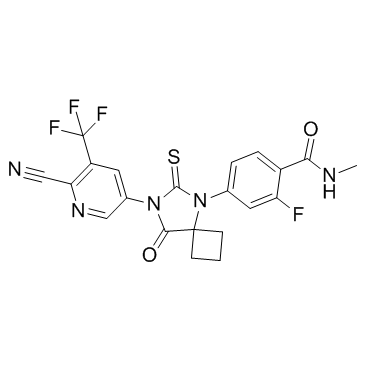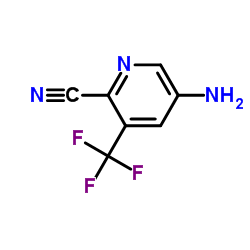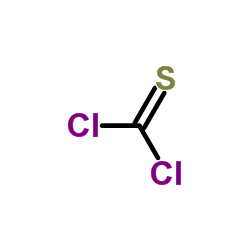956104-40-8
| Name | arn-509 |
|---|---|
| Synonyms |
QCR-211
4-[7-[6-cyano-5-(trifluoromethyl)pyridin-3-yl]-8-oxo-6-thioxo-5,7-diazaspiro[3.4]octan-5-yl]-2-fluoro-N-methylbenzamide ARN 509 4-{7-[6-Cyano-5-(trifluoromethyl)-3-pyridinyl]-8-oxo-6-thioxo-5,7-diazaspiro[3.4]oct-5-yl}-2-fluoro-N-methylbenzamide Benzamide,4-[7-[6-cyano-5-(trifluoromethyl)-3-pyridinyl]-8-oxo-6-thioxo-5,7-diazaspiro[3.4]oct-5-yl]-2-fluoro-N-methyl 4-[7-(6-cyano-5-trifluoromethylpyridin-3-yl)-8-oxo-6-thioxo-5,7-diazaspiro[3.4]oct-5-yl]-2-fluoro-N-methylbenzamide N-methyl-4-[7-(6-cyano-5-trifluoromethylpyridin-3-yl)-8-oxo-6-thioxo-5,7-diazaspiro[3.4]octan-5-yl]-2-fluorobenzamide 4-(7-(6-Cyano-5-(trifluoromethyl)pyridin-3-yl)-8-oxo-6-thioxo-5,7-diazaspiro(3.4)octan-5-yl)-2-fluoro-N-methylbenzamide ARN-509 apalutamide cc-670 4-[7-[6-cyano-5-(trifluoromethyl)pyridin-3-yl]-8-oxo-6-sulfanylidene-5,7-diazaspiro[3.4]octan-5-yl]-2-fluoro-N-methylbenzamide Benzamide, 4-[7-[6-cyano-5-(trifluoromethyl)-3-pyridinyl]-8-oxo-6-thioxo-5,7-diazaspiro[3.4]oct-5-yl]-2-fluoro-N-methyl- |
| Description | Apalutamide (ARN-509) is a potent and competitive androgen receptor (AR) antagonist, binding AR with an IC50 of 16 nM. |
|---|---|
| Related Catalog | |
| Target |
IC50: 16 nM (Androgen receptor)[1] |
| In Vitro | Apalutamide (ARN-509) also exhibits low micromolar affinity (IC50 3 μM) for the GABAA receptor in radioligand binding-assays and thus may potentially antagonize GABAA at therapeutic dose levels[1]. Apalutamide is a potent androgen receptor (AR) antagonist that targets the AR ligand-binding domain and prevents AR nuclear translocation, DNA binding, and transcription of AR gene targets[2]. |
| In Vivo | Apalutamide (ARN-509) exhibits low systemic clearance, high oral bioavailability and long plasma half-life in both mouse and dog, supporting once-daily oral dosing. Consistent with its long terminal-half-life, Apalutamide steady-state plasma-levels increases in repeat-dose studies, resulting in high C24hr levels and low peak:trough ratios (ratio:2.5). Castrate male mice bearing LNCaP/AR xenograft tumors are treated with either Apalutamide at doses of 1, 10 or 30 mg/kg/day. Thirteen of 20 Apalutamide (30 mg/kg/day)-treated animals exhibit >50% reduction in tumor-volume at day 28 versus 3 of 19 MDV3100 (30 mg/kg/day)-treated mice[1]. |
| Cell Assay | Trypsinized VCaP cells are adjusted to a concentration of 100,000 cells per mL in phenol-red-free RPMI 1640 (with 5% CSS), and dispensed in 16 µL aliquots into CellBIND 384 well plates. Cells are incubated for 48 hours, after which ligand is added in a 16 µL volume to the RPMI culture medium. For the antagonist mode assay, the ligands are diluted in culture medium also containing 30 pM R1881. After 7 days’ incubation, 16 µL of CellTiter-Glo Luminescent Cell Viability Assay is added and Relative Luminescence Units (RLUs) measured[1]. |
| Animal Admin | Mice[1] In vivo xenograft experiments to determine anti-tumor response are carried out in SHO SCID male mice. Mice are orchiectomized under isoflorane anesthesia and are given 2-3 days to recover prior to tumor cell injection. LNCaP/AR(cs) cells are suspended in 50% RPMI, 50% Matrigel, and 5×106 cells/xenograft are injected in a volume of 100 μL. Animals are observed weekly until tumor growth is apparent. From 24 d post-injection, tumors are measured weekly, and after 40-60 days post-injection, animals are randomized into cohorts of equivalent mean (150-250 mm3) and range tumor burden. All compounds (e.g., Apalutamide, 30 mg/kg per day) are administered daily by oral gavage. Statistical analyses are performed using Graphpad Prism. |
| References |
| Density | 1.6±0.1 g/cm3 |
|---|---|
| Molecular Formula | C21H15F4N5O2S |
| Molecular Weight | 477.435 |
| Exact Mass | 477.088257 |
| PSA | 121.42000 |
| LogP | 1.30 |
| Index of Refraction | 1.659 |
| Storage condition | -20°C |
|
~63% 
956104-40-8 |
| Literature: SLOAN-KETTERING INSTITUTE FOR CANCER RESEARCH Patent: WO2008/119015 A2, 2008 ; Location in patent: Page/Page column 54 ; |
| Precursor 3 | |
|---|---|
| DownStream 0 | |


